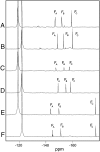Atomic details of near-transition state conformers for enzyme phosphoryl transfer revealed by MgF-3 rather than by phosphoranes
- PMID: 20164409
- PMCID: PMC2842025
- DOI: 10.1073/pnas.0910333106
Atomic details of near-transition state conformers for enzyme phosphoryl transfer revealed by MgF-3 rather than by phosphoranes
Abstract
Prior evidence supporting the direct observation of phosphorane intermediates in enzymatic phosphoryl transfer reactions was based on the interpretation of electron density corresponding to trigonal species bridging the donor and acceptor atoms. Close examination of the crystalline state of beta-phosphoglucomutase, the archetypal phosphorane intermediate-containing enzyme, reveals that the trigonal species is not PO-3 , but is MgF-3 (trifluoromagnesate). Although MgF-3 complexes are transition state analogues rather than phosphoryl group transfer reaction intermediates, the presence of fluorine nuclei in near-transition state conformations offers new opportunities to explore the nature of the interactions, in particular the independent measures of local electrostatic and hydrogen-bonding distributions using 19F NMR. Measurements on three beta-PGM-MgF-3 -sugar phosphate complexes show a remarkable relationship between NMR chemical shifts, primary isotope shifts, NOEs, cross hydrogen bond F...H-N scalar couplings, and the atomic positions determined from the high-resolution crystal structure of the beta-PGM-MgF--3 -G6P complex. The measurements provide independent validation of the structural and isoelectronic MgF--3 model of near-transition state conformations.
Conflict of interest statement
The authors declare no conflict of interest.
Figures





References
-
- Friedhoff P, et al. Kinetic analysis of the cleavage of natural and synthetic substrates by the Serratia nuclease. Eur J Biochem. 1996;241:572–580. - PubMed
-
- Stec B, Hehir MJ, Brennan C, Nolte M, Kantrowitz ER. Kinetic and x-ray structural studies of three mutant E. coli alkaline phosphatases: Insights into the catalytic mechanism without the nucleophile Ser102. J Mol Biol. 1998;277:647–662. - PubMed
Publication types
MeSH terms
Substances
Grants and funding
LinkOut - more resources
Full Text Sources

